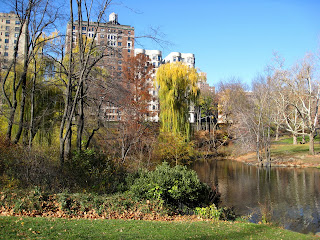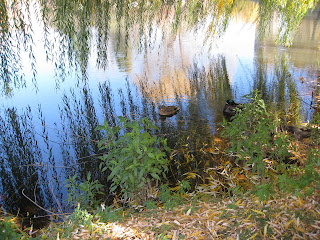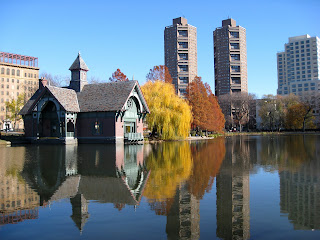We were hiking with AMC right in the middle of Manhattan, stepping our way to better health along the bridal path, park roads, paths and bridges, through ravine, loch, duck pond, Harlem Meer and Conservatory Garden. (The dirt paths and occasional hills allow the listing as a hike.)
Safety: Some parts of the Park can feel isolated at off times. It's more fun to have company, so please don't go alone.
For this walk, you'd do well to wear hiking shoes in case you come across some muddy spots.
Note: You would be greatly aided by a park map. At each park entrance, or "gate", the Central Park Conservancy has kiosks where you can ask for maps. These maps are excellent and can guide your walk when you want to digress for rest rooms or other marked sites that we bypass on this circuit. If you are not able to get a hard -copy color map,
here is the next best thing on line. For more information about park maintenance, events and free tours:
centralparknyc.org.
Route Summary: We made the round trip from the beginning of the bridle path up to the north end of the reservoir, then onto the paved paths, north through the Ravine and other loops in the North Woods,out to the Lasker Pool/rink, and then a spur to the east along the Harlem Meer and south to the Conservatory Garden at 5th Avenue. Then south (about 10 blocks) to pick up the bridle path again at the reservoir and continued walking back west and south to the end of the bridle path where we began. Our pedometers read 6 miles.
For questions, contact: Bernice and Dan.
Book List at end of Post
We took the subway to Columbus Circle and entered Central Park at 60th Street through The Merchants' Gate. Appropriately, the merchants were setting up their striped kiosks for the Christmas gift fair.
Good place to bypass if you're here for walking, so keep to the left and shop later, after you've covered the whole trail to complete the round trip.
You'll know the bridle path because it's unpaved. We love walking on the soft earth because it's so forgiving on the old bones, unlike hard pavement. As you step onto it and go northward (to your left), a look back to the right shows the end of the bridal path just beyond the bridge, your destination for the return.
At this point, still in the low 60s (numbered streets), our path led northwest, toward the periphery of the park.
This mini mall with gift shop, cafe and rest room, is the only operational part of the former, famous Tavern on the Green restaurant, which used to be the sheepfold, housing a shepherd and the flock that grazed the Sheep Meadow until 1934. Finally, it dawned on us why the large tract of land just across the path, a favorite meeting place for picnickers with blankets, is called
The Sheep Meadow!
That's a red-tailed hawk sitting on the middle branch just a second before he took flight. By now, most people have heard another hawk, Pale Male, a sometime perch hopper
here
. BTW, there is also an owl or two hanging around, but we didn't have the luck to see them that day.
As a point of interest, over 270 species of migratory birds have been sighted in Central Park, a major stopping point on the Atlantic Flyway.
December still gives the gift of fall foliage, though much sparser each week.As this section of our path hugs the western wall of the Park, we will be just bypassing Strawberry Field, The Lake, The Swedish Cottage, The Ramble, Belvedere Castle and The Delacorte Theater, all to our right.
This tree has the unique ability to graft crossing limbs into each other into closed, solid polygons. There are more than 26,000 trees in Central Park.
Double bridge. The design for Central Park is called "The Greensward Plan," submitted by Frederick Law Olmstead and Calvert Vaux. It includes 30 bridges and arches, and 11 overpasses across sunken transverse roads. It took 16 years to construct the Park. Central Park is the first major public park built in The United States.
The Reservoir, a 106-acre body of water, is surrounded by a 1.58 mile soft-surface running track. The fountain on the far side has 5 jets, one jet for each borough of NYC.
At the north end of the Reservoir, in The North Woods, we took the left fork of the bridle path, not the one that continues around the Reservoir, and we headed north. We left the bridle path altogether where it turns east. We continued north along The Loch.
The bridges and waterfalls of the Ravine reminded us of The Adirondack Mountains, which was the intention of Olmsted and Vaux. This end of the park was the site of military fortifications during the American Revolution and the War of 1812 because of the views it commanded of the rivers and Long Island Sound. Troups were quartered in The Arsenal during the Civil War.
Now, we find the tranquility of waterfalls ...
... and Rustic Bridges...
...fallen trees left in place -- trimmed only if they are blocking a path.
Then out of the woods to the Lasker Pool and Skating rink. At that moment, skaters waited off the ice while the ice-resurfacer machine did its job.
We hooked around the north of the rink, keeping Duck Island on our left.
The Charles A. Dana Discovery Center features hands-on exhibits and programs for all ages, including after-school activities, weekend workshops, and performances. Fishing poles are available for use at adjacent Harlem Meer. For hours and information, call: 212-860-1370.
The Conservatory Garden was our next stop, just south of The Meer, running along 5th Avenue, the eastern wall of the Park. Here we found the long shadows of late fall where last spring we had enjoyed the apple blossoms and fragrant lilacs. But artful nature presents beauty in any season in this 6-acre formal garden with spectacular displays of bulbs, perennials and annuals. The spring tulip display is not to be missed. Each spring, thousands of bulbs are planted, many gorgeous variations included, and then removed and donated elsewhere when blooms are spent. Only the first showing appears here.
This spiral suggests a maze now, but when in bloom, looks like a colorful tapestry to the residents on the Avenue looking down at the English garden from their windows above.
The 3 Graces, The Untermeyer Fountain, by Walter Schott.
Arcades, bowers, benches, a great place in the warmer months to sit and read a book.
This fountain and sculpture by Bessie Potter Vonnoh, was donated to the Garden as a memorial to playwright and author, Frances Hodgson Burnett, known to children for
The Secret Garden , A Little Princess,
, A Little Princess, 
and
Little Lord Fauntelroy .
.
We left the Garden and headed south. The East Meadow was closed and under restoration until the fall of 2011. We decided to walk outside on 5th Avenue until we reached the eastern side of The Reservoir.
About 10 blocks down, at 90th Street, we found the next entrance at Engineers Gate.
The Reservoir was just inside. At this point, the old pedometer read 4 1/2 miles.
We picked up the bridle path and stayed on it all the way around the south of the Reservoir, and then took the fork to the left (south) and didn't stop until ...
Voila. Back at the starting point. Time to have a treat. The food kiosk and Christmas market is just a bit to the right back at Merchants' Gate where it all started. We basked in the knowledge that we were 14.000 steps further along to better bone density, and continued weight control. Oh, no! We felt so good, we went and had the flapjacks at P.J.Clarks just across from Lincoln Center. What was that about weight control?
Recommended Related Books and Media:
1. Seeing Central Park:The Official Guide to the World's Greatest Urban Park .
. 2. 212 Views of Central Park: Experiencing NYC's Jewel from Every Angle
2. 212 Views of Central Park: Experiencing NYC's Jewel from Every Angle .
. 3. The Park and the People: A History of Central Park
3. The Park and the People: A History of Central Park .
. 4. The Papers of Frederick Law Olmsted: The Years of Olmsted, Vaux & Co
4. The Papers of Frederick Law Olmsted: The Years of Olmsted, Vaux & Co .
. 5. A Clearing in the Distance: Olmsted and America
5. A Clearing in the Distance: Olmsted and America


 .
. 6. Bridges of Central Park
6. Bridges of Central Park .
.
 7. Central Park, An American Masterpiece: A Comprehensive History
7. Central Park, An American Masterpiece: A Comprehensive History .
.



 As we entered the park, we glanced back to catch this glimpse of the Majestic's towers.
As we entered the park, we glanced back to catch this glimpse of the Majestic's towers. Another of the four grand apartment buildings that define Central Park West, the San Remo is just north of the Dakota and the Majestic. Many notable people have called this Art Deco beauty home, from Eddie Cantor and Hedy Lamar to Steve Jobs and Steve Martin.
Another of the four grand apartment buildings that define Central Park West, the San Remo is just north of the Dakota and the Majestic. Many notable people have called this Art Deco beauty home, from Eddie Cantor and Hedy Lamar to Steve Jobs and Steve Martin. Just inside Central Park, this pathway looks just like a country lane--in the middle of the Big City.
Just inside Central Park, this pathway looks just like a country lane--in the middle of the Big City. Strawberry Fields, one of Central Parks most visited sites is a memorial to John Lennon.
Strawberry Fields, one of Central Parks most visited sites is a memorial to John Lennon.









































